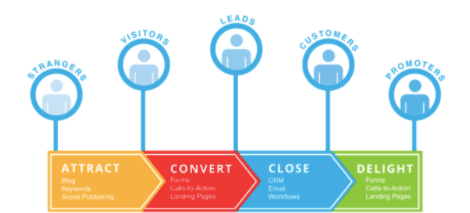How can businesses turn strangers into customers? Inbound marketing is a methodology that involves creating valuable content that caters to specific audiences. Discover how the four inbound methodology stages attract customers to businesses.
The mission of any successful business is to attract customers. This approach goes beyond an initial hello or purchase.
The inbound methodology is the method of growing your organization and business by crafting meaningful relationships with prospective customers and consumers.
For businesses looking to empower their customers with other digital marketing strategies, their team should consider investing in inbound methodology and its four simple stages.

Each step attracts prospective customers and employs its own set of tactics to encourage lasting relationships.
4 Inbound Methodology Stages:
- Attract
- Convert
- Close
- Delight
1. Attract
The first inbound methodology stage involves making your prospects aware of your business and the services you offer.
If you want to turn strangers into visitors, you have to start by making them feel welcome.
The key to success is to target potential customers that are more likely to be interested in your product.
Businesses should address why a customer needs their service or product right at the start.
That question should be answered through valuable content and interactive elements on your website or through social media channels.
Consumers are an inquisitive bunch, so it’s best to provide as much information as possible to address their needs.
For example, if you own a web design company, you want to have a website that details your company’s offerings, past work, and levels of service.
Promoting your content on other channels outside of your website is another way to successfully attract future customers.
Produce relevant content online that is optimized for search and promote it on key channels online.
For example, promoting your fashion brand on Instagram is a good opportunity to attract your target audience through showcasing your product and social media aesthetic.
Finding opportunities to make customers aware of your business is the first stage in a long buyer’s journey.
2. Convert
Once you’ve attracted potential customers, it’s time to convert them into leads.
At this stage, your business wants to get to know more about your customers.
By more, we mean learning about their personal information like their email address, social media handles, phone numbers, or any other avenue to contact them.
The question is: how does your business get someone’s email address?
Spam emails accounted for over 45% of email traffic in the spring of 2021. To avoid your company being seen as another opportunity for a cluttered inbox, businesses must think creatively about how to encourage prospects to give over their contact information.
Businesses need to offer something useful that will compel users to agree to exchanging their information.
Examples could be offering a free consultation or providing a discount code for their first purchase.
It’s important to make offers that will generate interest from your target audience.
Once you’ve converted your first lead through viral email marketing, it’s time to turn them into a lasting customer.
3. Close
It’s not the amount of initial leads your company receives, it’s how many of them actually turn into a paying customer.
Your business needs to show your leads the right amount of attention without being too overwhelming. You have to strike the right balance.
If you go overboard, your lead will quickly hit the “unfollow” button, and will make no time to return.
Along with spacing out communication, businesses need to tailor their offers to their customers’ unique needs as much as possible.
Your business needs to invest in CRM retargeting efforts to effectively understand how your email marketing leads are converting and why.
When you have that information, you can focus your inbound marketing efforts around what’s making your customers happy.
4. Delight
The journey doesn’t stop once your business converts your prospects into loyal customers.
It is one thing to have a customer that frequently uses their services; it’s another to have a customer that frequently recommends your business to their friends and family.
These referrals and recommendations can significantly impact your business growth.
Delighting your customers has a direct impact on your business, so make them feel special and encouraged by the fact that they chose your company.
Continue offering them personalized services, engage with them on social media, and send them newsletters.
Find opportunities to connect to keep them satisfied and loyal.
Explore content marketing packages to help with your overall inbound strategy.
Turn Leads into Customers Through Inbound Methodology Stages
By using inbound marketing and following the inbound methodology stages, businesses can effectively turn leads into customers by delivering exceptional support and service.
- Attract online browsers into becoming visitors
- Convert those visitors into initial leads
- Close those leads by turning them into customers
- Delight those customers by encouraging them to become loyal promoters of your business
Companies can grow their business by leveraging each inbound methodology stage to their advantage.